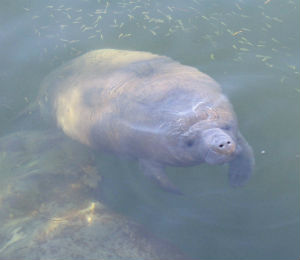Floridans in general and residents of Key West in particular hold a special place in their heart for the manatee, affectionately nicknamed sea cows by the natives. Those planning to go on a Key West snorkeling tour should make a definite effort to keep an extra eye out for these gentle giants, who are the state's official marine mammal. Though it is illegal to hunt or harass manatees, there is no rule against pictures, as many delighted tourists can attest. These animals, while large, are remarkably placid and can be safely observed even at a close distance.
Manatee Appearance
Manatees belong to the order Serenia, romantically named by presumably shortsighted sailors who thought they were seeing mermaids. They are large barrel shaped marine mammals with gentle eyes who usually weigh about 1,300 pounds, though a large one can also weigh more than twice that number on occassion. Likewise, a large full grown manatee can be as long as 13 feet long, making them an intimidating sight, though most are not quite that long. They are a long lived animal and can live easily to 50 or 60 if not killed first by predators or by a boat propellor, an avoidable tragedy that claims an unfortunate number of manatee lives each year. They use a paddle shaped tail to proppel themselves, though they don't move very quickly as a rule.
Manatees usually have only a single calf per pregnancy, though occassionally twins may also be born. These calves take several years to mature and are not considered adults until they are about 9 feet long and 5 years old. One physical quirk of the manatee is that they still have fingernails, a remant from a time when they still lived on land. There is also a hand-like bone structure in their fins, further evidence of their landlocked past. They are a grey color, but can look green sometimes since algae grows on their back.
Manatee Eating Habits
Manatees are herbivores who enjoy munching on seagrass and other marine plants. They will occassionally accidentally eat a fish, but generally stay away from eating anything but plants. They can eat up to 200 pounds each day, or about 15 percent of their body weight. Due to the wear and tear the tough plants and sandy particles cause to their teeth, they replace them throughout their life, with the newer teeth coming in at the back of their mouth. They usually have no more than two dozen teeth at a time.
Manatee Habitats
There are three living species of manatee, and though they all prefer warm water the only specie found in the waters around Key West is the West Indian Manatee. Despite their size they get cold easily and need to stay in warm water, and can in fact die of hypothermia in waters colder than 60 degrees. Due to this and their plant diet, they prefer warm, shallow coastal waters where plenty of vegetation grows.




